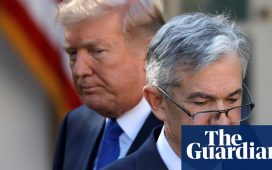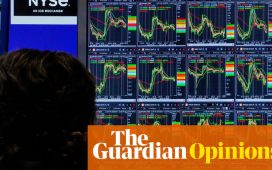Unlock the Editor’s Digest for free
Roula Khalaf, Editor of the FT, selects her favourite stories in this weekly newsletter.
This article is an on-site version of our Unhedged newsletter. Sign up here to get the newsletter sent straight to your inbox every weekday
Good morning. Oracle reported a slightly disappointing quarter, and the $275bn software company’s shares fell 12 per cent yesterday. There is a lot of optimism in markets right now, creating the possibility of bitter disappointments. If you know which stock will get whacked next, by all means email us at once: robert.armstrong@ft.com and ethan.wu@ft.com.
Inflation
We wrote yesterday that only a ferociously hot CPI report would change the market consensus. In the event, the report was meek and mild. The two-year yield, highly sensitive to incoming economic data, did not budge.
The report did, however, contain several interesting hints about how inflation’s descent may play out. First, core goods prices fell 0.3 per cent month over month. Goods deflation has been a feature of inflation reports for half a year, driven by declining used car prices. This time, however, used cars and trucks actually rose 1.6 per cent in November, the first monthly increase since May. Core goods ex-used cars fell 0.6 per cent, the biggest decline since early 2020. Some analysts suggested holiday discounting was at work.
Next, shelter. Lagged CPI rental inflation should follow private-market rents down as newly signed leases enter the official data. But the process is taking longer than many expected. Rents rose 0.4 per cent in November, an uptick from the previous month. One reason is that the standard measures of market rents, from the likes of Zillow and Apartment List, are relatively new. “We haven’t tested this [relationship] over multiple cycles,” says Carl Riccadonna, US economist at BNP Paribas. “We know generally how the relationship should work, but don’t necessarily understand nuances [such as] magnitude or exactly how long lags will take.”
Eventually, shelter inflation should fall sharply. Researchers at Penn State University keep a live model of inflation adjusted using real-time market rental data. After those adjustments, core inflation is already back to target:

Finally, non-shelter services (aka “supercore”) jumped higher, to 0.4 per cent in November from 0.2 per cent in October. The culprit was an abnormally large monthly increase in medical care prices, which rose 0.6 per cent. Despite a slight deceleration, car insurance inflation kept up its relentless rise, up 1 per cent in November.
Put together, these points provide a sense of why inflation’s descent may not be smooth. The Federal Reserve has strongly suggested it will look past goods deflation; shelter is taking its sweet time to fall; and non-housing services are very volatile. None of that necessarily violates the view that inflation is on course to get sustainably into the 2’s, but the lack of clarity gives the Fed’s hawks a reason not to rush.
Which volatility is right?
Here’s a striking chart:

That is the ratio of the Move index of implied short-term Treasury volatility to the Vix index of implied short-term S&P 500 volatility. Both indices are based on option prices. It shows that implied US interest rate volatility is higher, relative to expected US equity volatility, than it has been in almost 30 years.
From a certain perspective, it is not that weird that equity volatility is so low or (in the derivative-industry argot) “cheap” relative to rates volatility. We are at a transition period in monetary policy which follows the most violent inflationary incident since the early 1980s. What rates do next is very uncertain! At the same time, the economy, while it is slowing, is doing so from a high level and in an orderly fashion, and so equities ought to be OK whichever way rates go, unless there is recessionary rate collapse. That summary is too simple and probably too optimistic, but there is a certain logic to it.
In another way, though, the divergence between the two volatilities is very weird. Volatility in the cost of money should show up, one way or another, in the volatility of equities; and the economic uncertainties that make it hard to know where rates are headed ought to be reflected in equity prices, too. It is therefore tempting to declare that one of the two volatilities is “right”: that equity risk is underpriced or bond risk is overpriced, or a bit of both.
Nitin Saksena, head of US equity derivative research at Bank of America, offered several explanations for the gap:
-
Fundamentals may justify it (in roughly the way I described above).
-
It reflects supply and demand for rate and equity options. Excessive selling of equity derivatives — for example increasingly popular covered-call strategies — depress their prices and therefore equity volatility.
-
Technical or “mechanical” factors suppress equity volatility. For example, low correlation among S&P 500 constituents this year, which means individual stock moves cancel each other out, diminishes volatility at the index level.
-
While rates volatility broadly reflects current economic uncertainty, equities and equity volatility have become “numb” to it because equity investors “have been conditioned over the years to buy dips and fear upside risk more than downside risk”.
Saksena thinks that the first three explanations are playing a role, but are not strong enough to explain the extreme divergence. The fourth explanation is crucial.
If Saksena is right, one would expect that equity investors will be shaken out of their trance by some sort of shock eventually. But how to time such an event? He writes:
A lot must go right for low Vix to remain the norm for all of 2024 . . . equities would need to stay on the soft-landing “balance beam” and avoid getting knocked off by either recession or higher-for-longer rates — both equity vol positive historically. And at the single stock level, an “immaculate rotation” out of the Mag 7 [Big Tech stocks] into this year’s laggards would need to dominate, as the alternatives of (i) the Mag 7 becoming more magnificent and trading at higher P/Es or (ii) the Mag 7 bubble bursting should [both] drive equity vol higher.
Amy Wu Silverman, equity derivatives strategist at RBC Capital Markets, emphasises the problem of timing:
From a cross-asset perspective it is very compelling to say “equity vol looks cheap” relative to rates vol, but the reality is we can stay in this framework for quite a while. It is always an issue in our world [derivatives trading] that we don’t know “when the music stops”. Take a look at all of 2017 for instance leading into the Volmageddon of 2018 . . . [with that said], what is the market least positioned for in terms of options[?] a gap to the downside in equity markets from some sort of exogenous shock.
Be careful out there.
One good read
Fiona Hill: “Ukraine has become a battlefield for America and America’s own future.”
FT Unhedged podcast

Can’t get enough of Unhedged? Listen to our new podcast, hosted by Ethan Wu and Katie Martin, for a 15-minute dive into the latest markets news and financial headlines, twice a week. Catch up on past editions of the newsletter here.








